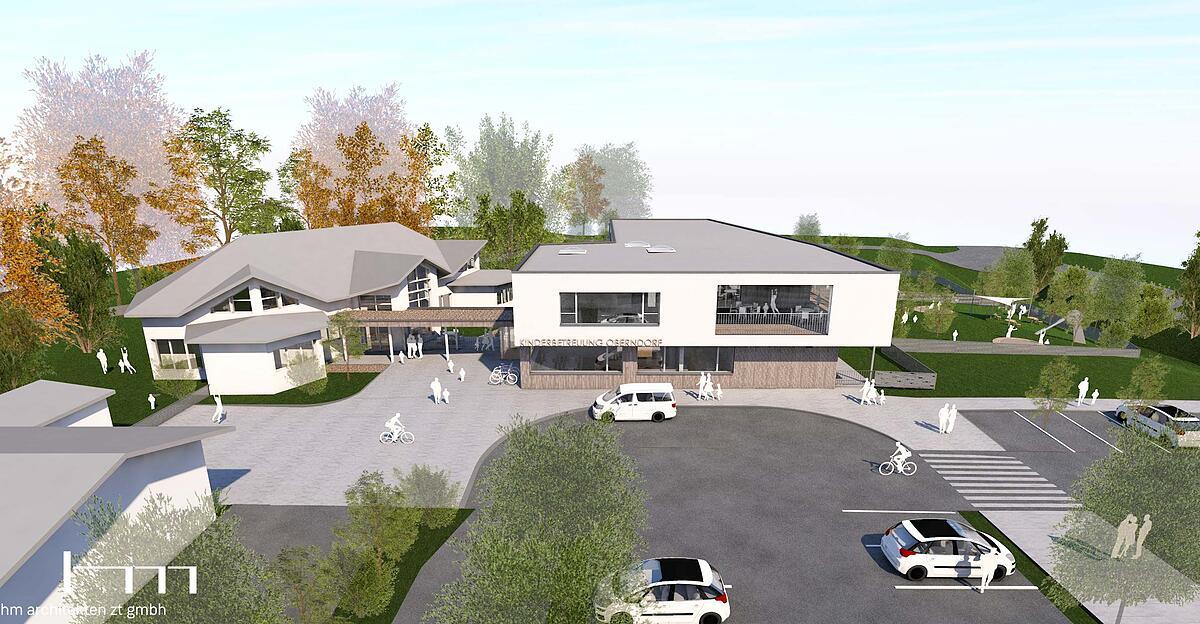When Rupert Imlinger opened a playroom for children aged 15 months and over in January 2001, he had to explain himself. The mayor (VP) of Oberndorf near Schwanenstadt (Vöcklabruck district) was asked at the time whether this was really necessary and not too expensive. And anyway: Such small children? They should be at home with their parents. More than 22 years later, the crèche in Oberndorf, the first of its kind in the region, has more registrations than places. And Imlinger is once again in the pioneering role. At least as far as the Oberndorf location is concerned.
Since yesterday, what Upper Austria’s deputy governor Christine Haberlander (VP) calls a “tremendous step towards becoming the number one children’s area” has been taking shape there.
Six groups in a new house
From autumn 2025, up to 99 children from eight communities will come and go on Atzbacher Landesstraße, right next to the Oberndorf community’s kindergarten and playroom.
Oberndorf, Schwanenstadt, Rutzenham, Niedertalheim, Pühret, Pitzenberg, Atzbach and Schlatt have joined forces for this purpose. Together, the communities in the Vöcklabruck district have around 11,400 inhabitants. Three kindergarten groups and three toddler groups will be accommodated in the wooden hybrid house, for which the groundbreaking ceremony took place yesterday. A play and adventure room in the garden is also planned.
The costs amount to around 3.4 million euros, 90 percent of which comes from state and federal funding. The communities will divide the remaining amount among themselves. “This project is a crucial location factor for the entire region,” says Christian Mader, municipal association president and mayor (VP) of Schlatt. The existing kindergartens and playrooms in the participating communities would “of course” remain unchanged. All mayors of the eight municipalities see the new childcare facility as an added value for the region.
A key to success will also be successful personnel searches. “With six groups, we need at least twelve, ideally fourteen teachers. “It will be another challenge,” says Imlinger.
Bad report card for the district
More than 67,000 children currently attend the 1,324 institutional children’s education and care facilities in Upper Austria. A look at the Upper Austrian Chamber of Labor’s childcare atlas, which was published yesterday, shows that the new house will be important for the region. Accordingly, only four of 52 municipalities in the Vöcklabruck district (Lenzing, Pilsbach, Schwanenstadt and Vöcklabruck) offer full-time care.
With Tiefgraben there is only one municipality that offers parents of children under three years of age full-time care. Only 7.7 percent of the municipalities in the district are in category 1A (Upper Austria average 18.7). To do this, communities must meet at least eleven of twelve defined criteria (including the extent of daily opening hours, lunch offerings, summer care, and the total number of closing times over the course of a working year).
SP education spokeswoman Doris Margreiter sees the “number one children’s area” becoming a long way off. Although the measures adopted in the new child education and care law (including smaller groups, longer opening times) are welcome, they are not covered by the funding. More financial resources are needed from the state government.
ePaper
Read the ePaper now!
Read the daily ePaper edition of the OÖNachrichten – browse through it digitally now!
to the e-paper
Author
Gabriel Egger
Editor Upper Austria
Gabriel Egger
info By clicking on the icon you can add the keyword to your topics.
info By clicking on the icon you open your “my topics” page. You have saved 15 tags and need to remove tags.
info By clicking on the icon you can remove the keyword from your topics.
Add the topic to your topics.
2023-10-11 19:48:54
#communities #create #space #children
